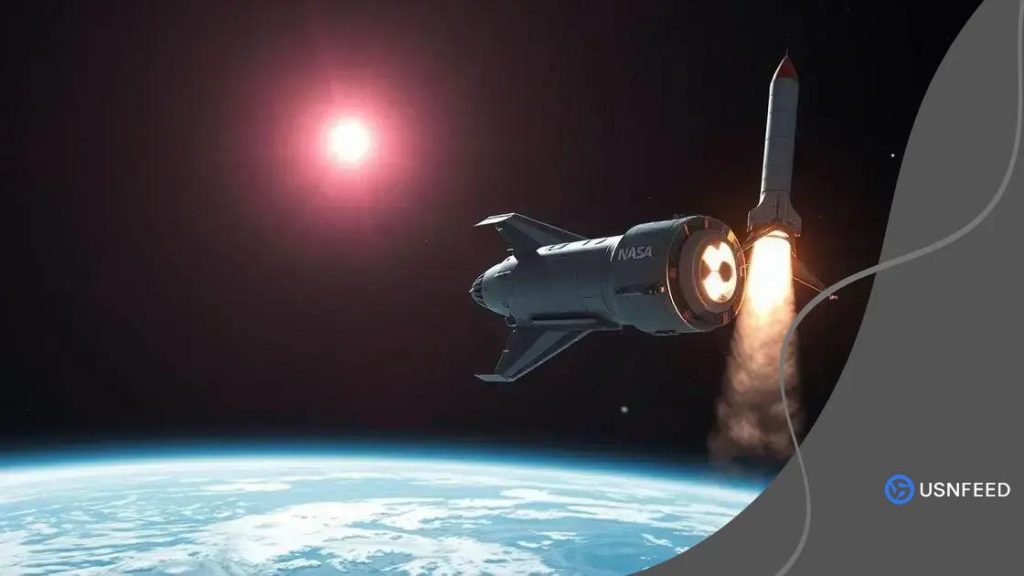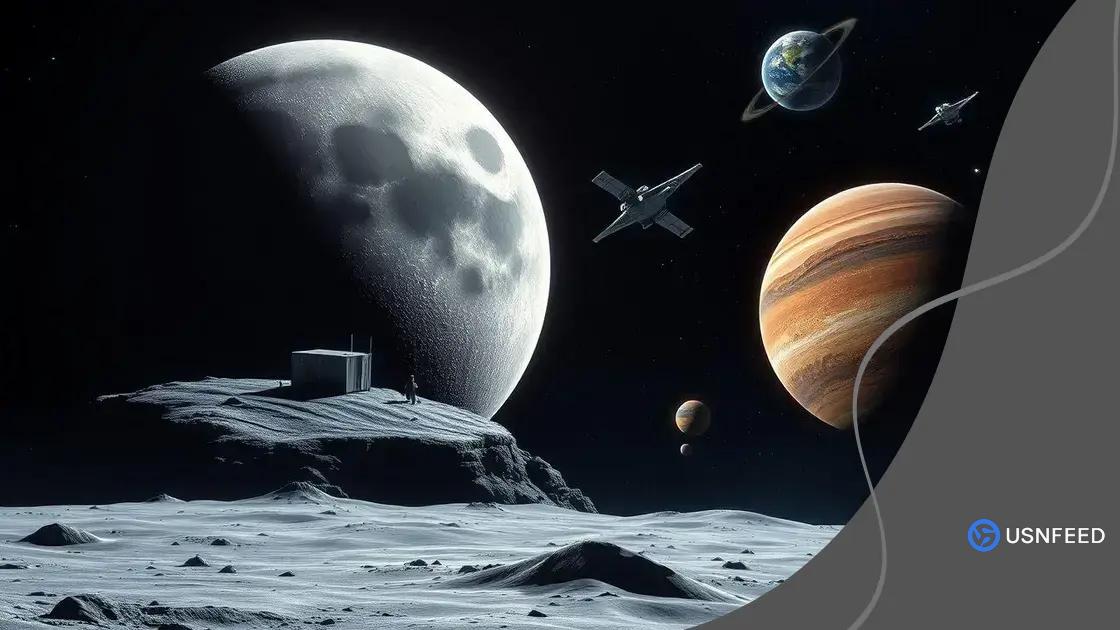Space exploration news from NASA: latest findings

NASA’s exploration efforts focus on advancing our understanding of the universe through innovative technology, public engagement, and valuable scientific research, aiming for future missions to the Moon and Mars.
Space exploration news from NASA is not just about rockets and planets; it’s about understanding our universe. Have you ever wondered what new discoveries are unfolding beyond our atmosphere? Let’s dive into the latest updates and their implications.
Recent missions and their findings
Recent missions from NASA are providing us with incredible insights into space. Each mission reveals more about our universe and its mysteries. These findings are shaping our understanding and inspiring the next generation of explorers.
Highlights of Key Missions
From Mars rovers to lunar exploration, NASA’s missions cover a vast range of objectives.
- The Perseverance rover is searching for signs of ancient life on Mars.
- Artemis I aims to pave the way for human exploration of the Moon.
- The James Webb Space Telescope is uncovering details about distant galaxies.
- Ingenuity, the Mars helicopter, is proving powered flight is possible on another planet.
NASA’s recent missions focus on exploration, technology, and science. For example, the Perseverance rover has already gathered data that might help scientists understand Mars’s past climate. This mission also aims to collect samples for future return to Earth.
Impacts of Scientific Discoveries
Every new discovery has far-reaching implications. The data collected can lead to breakthroughs in technology, sustainability, and our understanding of life beyond Earth. NASA collaborates with scientists worldwide, amplifying the impact of their findings.
As we look to the future, these missions not only deepen our knowledge but also foster international partnership in science. The excitement surrounding these advancements fuels interest in space exploration and encourages young minds to pursue careers in STEM fields.
Technological advancements in space exploration
Technological advancements in space exploration have revolutionized our understanding of the universe. These innovations are making missions safer, more efficient, and more impactful. With each new technology, we get closer to uncovering the secrets of space.
Key Innovations Transforming Space Travel
NASA’s focus on technology has led to groundbreaking discoveries.
- Autonomous systems allow spacecraft to navigate without constant human input.
- Advanced propulsion systems shorten travel times to distant planets.
- 3D printing is enabling the production of tools and parts in space.
- High-resolution imaging technology is capturing stunning details of celestial bodies.
Moreover, innovations such as small satellites are playing a crucial role in gathering data. These satellites are easier to deploy and can work together in constellations, enhancing the richness of the data collected.
Impact on Future Missions
These technological advancements not only improve current missions but also lay the groundwork for future exploration. The goal is to send humans to Mars within the next few decades. To achieve this, we need reliable systems that can support life on another planet.
Furthermore, investments in artificial intelligence are helping scientists analyze large data sets from missions more efficiently. AI can identify patterns that might go unnoticed by human researchers, making space research faster and more accurate.
Future goals of NASA

NASA has exciting future goals that aim to push the boundaries of space exploration. These ambitions focus on sending humans deeper into space and unraveling the mysteries of the universe. Each goal signifies both a roadmap for future missions and a commitment to furthering human knowledge.
Expanding Human Presence
One of the primary objectives is to return humans to the Moon through the Artemis program. The first mission, Artemis I, has already set the stage, and future missions will land astronauts on the lunar surface.
- Establishing a sustainable base on the Moon.
- Using the Moon as a launching point for Mars exploration.
- Conducting scientific research to understand lunar resources.
This effort aims to prepare for a crewed mission to Mars, which is another critical objective. NASA plans to land humans on Mars within the next couple of decades, aiming for a launch in the 2030s.
Exploration of Mars and Beyond
NASA’s goals also include sending robotic systems to Mars to explore its environment further and search for signs of ancient life. These missions will gather data to support future human exploration, ensuring the safety and effectiveness of prospective manned missions.
In addition to Mars, there are plans for probes to study the moons of Jupiter and Saturn. These distant worlds may hold valuable information about the origins of our solar system and the possibility of extraterrestrial life.
Impacts on scientific research
The impacts of NASA’s missions on scientific research are profound and far-reaching. Each mission generates invaluable data that contributes to various fields including geology, biology, and astronomy. This data often leads to breakthroughs that enhance our understanding of the universe.
Data Collection and Its Significance
Nasa’s missions collect a variety of data that scientists analyze to answer important questions.
- Environmental data from Mars helps understand planetary climates.
- Samples from the Moon provide insights into Earth’s early history.
- Discoveries related to astrobiology expand our knowledge of life beyond Earth.
- Observations from space telescopes enhance our grasp of the universe’s expansion.
This wealth of information aids not only space scientists but also researchers working in related fields. For instance, data about the chemical makeup of other planets could impact theories about the formation of our own planet.
Collaborative Research and Innovations
The findings from NASA also stimulate collaboration across disciplines. Universities and research institutions worldwide utilize this data to fuel new hypotheses and explore uncharted territories in science.
As scientists analyze findings, they develop new technologies and methods that benefit society. Technologies such as satellite imaging, which revolutionized weather forecasting, originated from space research.
Public engagement with space discoveries
Public engagement with space discoveries is crucial for fostering interest in science and exploration. NASA uses various strategies to connect with people and share the excitement of space missions. These efforts inspire the next generation of scientists and astronauts.
Interactive Programs and Events
Nasa has developed numerous programs that allow the public to interact with scientists and learn about ongoing projects.
- Public lectures offer insights directly from experts.
- Science fairs and exhibitions showcase new technologies and findings.
- Workshops engage students in hands-on activities related to space.
- Online webinars provide access to lectures and discussions for global audiences.
These initiatives create a lively environment for learning and discovering. They encourage questions and participation from people of all ages.
Social Media and Online Platforms
Nasa’s active presence on social media platforms allows for real-time communication. Their posts share stunning images and updates about missions. They also encourage discussions and questions, creating a sense of community among space enthusiasts.
Additionally, educational videos and livestreams provide further insights into mission objectives and findings, making complex topics accessible. These resources enhance public understanding of space exploration and its importance.
FAQ – Frequently Asked Questions about NASA and Space Exploration
What are NASA’s future goals for space exploration?
NASA aims to return humans to the Moon and eventually send astronauts to Mars, focusing on sustainable exploration and scientific discoveries.
How does NASA engage the public with its discoveries?
NASA uses public lectures, social media, and hands-on events to share its findings and inspire interest in space and science.
What impact does NASA’s research have on scientific fields?
NASA’s missions provide valuable data that enhances understanding in areas like geology, biology, and astronomy, fostering collaboration across disciplines.
What technological advancements is NASA currently working on?
NASA is developing autonomous systems, advanced propulsion technologies, and innovative materials to improve space travel and exploration.